
views
Removing the Old Battery

Park on a level surface in a secure area and turn off your vehicle. Avoid changing your battery on the side of the road when at all possible. Find a safe place to work that’s well away from traffic, sparks, open flames, or water. Engage your parking brake and turn your vehicle off. Remove the keys from the ignition to ensure no power is going to the battery. A garage or driveway is a good place to change your battery. Just make sure the area is well-ventilated (i.e. keep the garage door open). Disconnecting the battery will reset the clock, radio, navigation, and alarm settings so make sure you know your alarm code before you get started. If you don't remember it, check your owner's manual.

Put on safety gear and pop your hood. Batteries contain a sulfuric acid electrolyte solution, which is highly corrosive, can burn your skin, and produces flammable hydrogen gas. Put on insulated work gloves and safety goggles to protect yourself. Then, open your hood and prop it up with a rod, if necessary. Take off any metal jewelry you’re wearing, like a watch or ring, to protect yourself from electric shock. Wear old clothes that you don’t mind getting greasy.
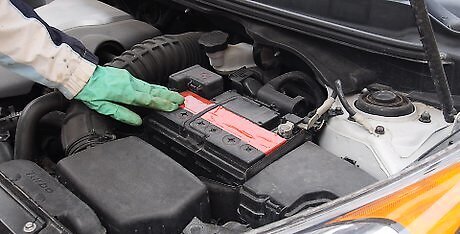
Locate the battery. Look for the battery in one corner of the engine bay, either near the windshield or the front bumper on either side of the car. Find the rectangular battery box which has 2 cables attached to it. If you have a newer car, the battery might be underneath a plastic cover, so remove the cover if necessary. Refer to your owner’s manual if you aren’t able to find the battery. Note that on some vehicles, the battery is located in the trunk rather than under the hood.
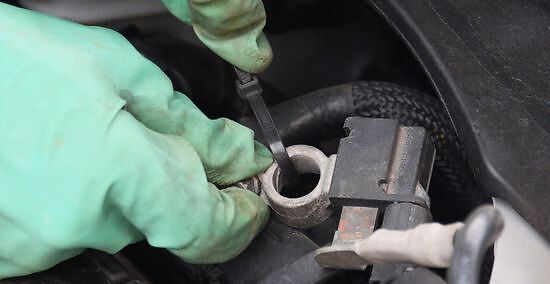
Disconnect the negative cable first and secure it with a cable tie. Always remove the negative cable before the positive cable to prevent electrical shorts. The negative battery terminal is usually black and may have a minus sign (-) near it. Remove the plastic cover, if applicable, then loosen the negative cable clamp with a wrench and slide the cable off the terminal. Use a cable tie to secure the negative cable to the engine bay, making sure it doesn’t come into contact with anything metal. Depending on the vehicle, you may need a 7-mm, 8-mm, 10-mm, or 13-mm wrench to remove the cables. However, if your battery terminals have quick-release clamps, you won’t need any tools to remove the cables.
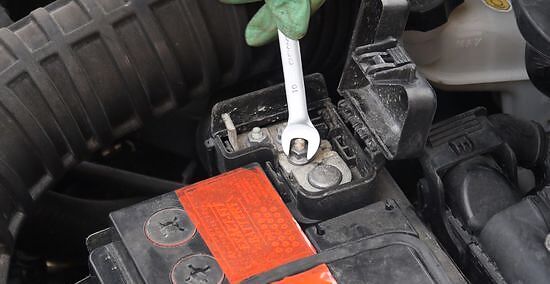
Disconnect the positive cable next and secure it with a cable tie. The positive terminal is typically red and might be marked with a plus sign (+). Remove the plastic cover over the terminal, if your vehicle has one, then use a wrench to loosen the positive cable clamp and take the cable off of the terminal. Secure the cable to the engine bay with a cable clamp.Warning: Make sure the positive and negative cables do not touch each other and do not allow them to touch anything made of metal as this can cause a dangerous electrical short.
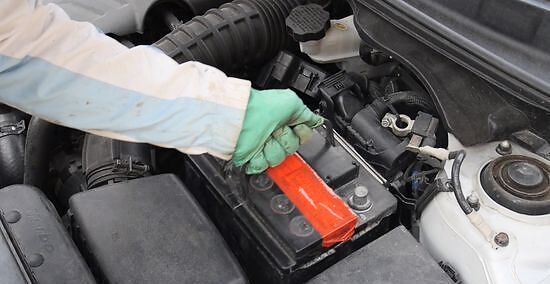
Remove the battery from the vehicle. Inspect the bracket that secures the battery in place and remove any connectors that hold the battery to the bracket. You may need a socket wrench, the right-size socket, and an extension bar. Once you’ve removed all the fasteners, lift the battery out of the engine bay and set it aside on a concrete surface, if possible. The battery may weigh more than 20 pounds (9.1 kg), so ask a friend for help if you can't lift it yourself.
Installing the New Battery

Clean the battery terminals to remove corrosion. Check the terminals for powdery buildup, which may be green, blue, gray, or white. Use an emery cloth or 100-grit sandpaper to carefully clean the corrosion off of the terminals until they’re shiny. Remember that battery acid is corrosive, so avoid getting it on your skin or clothes.
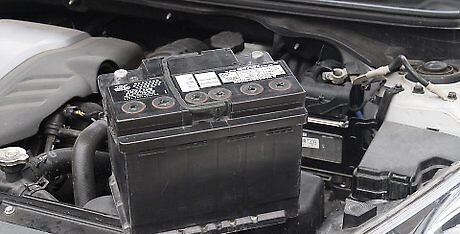
Buy the correct replacement battery. Take a picture of or write down any information on the old battery, such as the size, dimensions, and part number. Head to an auto parts store and give the clerk this information as well as the year, make, model, and engine size of your vehicle. They will be able to find you the appropriate replacement. Automotive batteries vary in size and electrical capacity so make sure you purchase one designed for your specific vehicle. If it's not the right size, the battery might not fit correctly in the cavity where it's supposed to sit. If you live in the U.S., you may want to bring the old battery with you. Some auto parts stores will let you trade in the old battery so you don’t have to pay a “core fee” for the new one. If the auto parts store won’t take the old battery off your hands, take it to a service or recycling center for disposal. Do not throw it away because it contains corrosive material.
Secure the new battery to the bracket and grease the terminals. Place the new battery in the battery tray and secure it to the bracket. Simply reverse the process you used to remove the battery from the bracket. Then, coat each of the terminals in a thin layer of lithium grease to prevent corrosion. Make sure the battery is oriented the same way as the old one. Check that all the fasteners on the bracket are secure so the battery doesn’t vibrate or move around while you’re driving. Do not spray the lithium grease on any other parts of the engine block other than the positive and negative terminals.
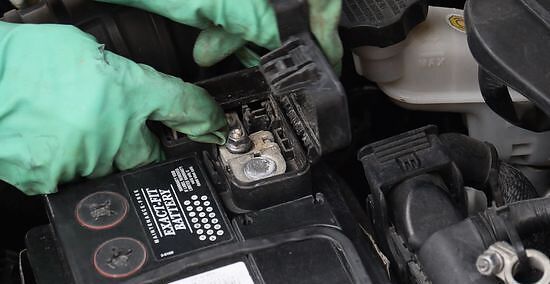
Reconnect the positive cable first. Undo the cable tie securing the positive cable to the engine bay, being careful not to touch the end of it to anything metal. Put the cable over the terminal and tighten it down with a wrench. Put the cover over the terminal, if the battery has one.Warning: When you’re reconnecting the battery, always secure the positive terminal before the negative terminal so as not to inadvertently complete the electrical circuit before everything is connected.

Reconnect the negative cable next. Repeat the process to remove the cable tie and reattach the negative cable to the negative terminal. Tighten the clamp with a wrench and make sure neither the wrench nor the negative cable come into contact with anything metal, as this could cause a dangerous electrical discharge. If your battery has a plastic cover, replace it at this time.
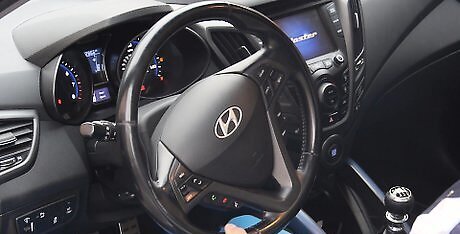
Close the hood and start your vehicle. Check that you removed all tools from under the hood, then close it. If you’ve done everything correctly—and the battery truly was the cause of any power problems you were having—your car should start right up. If necessary, enter the alarm code. Make sure all of your electronic devices are working properly, then reset your clock, radio, and navigation system.




















Comments
0 comment